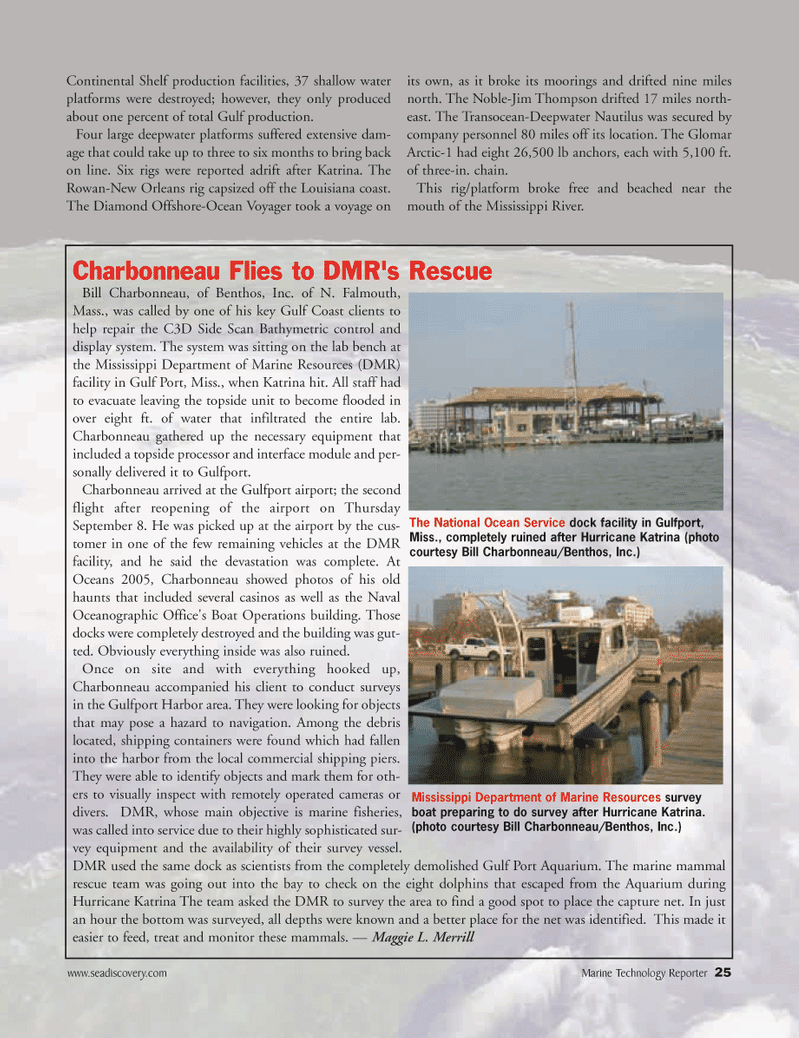
Page 25: of Marine Technology Magazine (November 2005)
Seafloor Engineering
Read this page in Pdf, Flash or Html5 edition of November 2005 Marine Technology Magazine
www.seadiscovery.com Marine Technology Reporter 25
Continental Shelf production facilities, 37 shallow water platforms were destroyed; however, they only produced about one percent of total Gulf production.
Four large deepwater platforms suffered extensive dam- age that could take up to three to six months to bring back on line. Six rigs were reported adrift after Katrina. The
Rowan-New Orleans rig capsized off the Louisiana coast.
The Diamond Offshore-Ocean Voyager took a voyage on its own, as it broke its moorings and drifted nine miles north. The Noble-Jim Thompson drifted 17 miles north- east. The Transocean-Deepwater Nautilus was secured by company personnel 80 miles off its location. The Glomar
Arctic-1 had eight 26,500 lb anchors, each with 5,100 ft. of three-in. chain.
This rig/platform broke free and beached near the mouth of the Mississippi River.
Charbonneau Flies to DMR's Rescue
Bill Charbonneau, of Benthos, Inc. of N. Falmouth,
Mass., was called by one of his key Gulf Coast clients to help repair the C3D Side Scan Bathymetric control and display system. The system was sitting on the lab bench at the Mississippi Department of Marine Resources (DMR) facility in Gulf Port, Miss., when Katrina hit. All staff had to evacuate leaving the topside unit to become flooded in over eight ft. of water that infiltrated the entire lab.
Charbonneau gathered up the necessary equipment that included a topside processor and interface module and per- sonally delivered it to Gulfport.
Charbonneau arrived at the Gulfport airport; the second flight after reopening of the airport on Thursday
September 8. He was picked up at the airport by the cus- tomer in one of the few remaining vehicles at the DMR facility, and he said the devastation was complete. At
Oceans 2005, Charbonneau showed photos of his old haunts that included several casinos as well as the Naval
Oceanographic Office's Boat Operations building. Those docks were completely destroyed and the building was gut- ted. Obviously everything inside was also ruined.
Once on site and with everything hooked up,
Charbonneau accompanied his client to conduct surveys in the Gulfport Harbor area. They were looking for objects that may pose a hazard to navigation. Among the debris located, shipping containers were found which had fallen into the harbor from the local commercial shipping piers.
They were able to identify objects and mark them for oth- ers to visually inspect with remotely operated cameras or divers. DMR, whose main objective is marine fisheries, was called into service due to their highly sophisticated sur- vey equipment and the availability of their survey vessel.
DMR used the same dock as scientists from the completely demolished Gulf Port Aquarium. The marine mammal rescue team was going out into the bay to check on the eight dolphins that escaped from the Aquarium during
Hurricane Katrina The team asked the DMR to survey the area to find a good spot to place the capture net. In just an hour the bottom was surveyed, all depths were known and a better place for the net was identified. This made it easier to feed, treat and monitor these mammals. — Maggie L. Merrill
Mississippi Department of Marine Resources survey boat preparing to do survey after Hurricane Katrina. (photo courtesy Bill Charbonneau/Benthos, Inc.)
The National Ocean Service dock facility in Gulfport,
Miss., completely ruined after Hurricane Katrina (photo courtesy Bill Charbonneau/Benthos, Inc.)
MTR#3 (17-32).qxd 11/14/2005 1:00 PM Page 25

 24
24

 26
26
